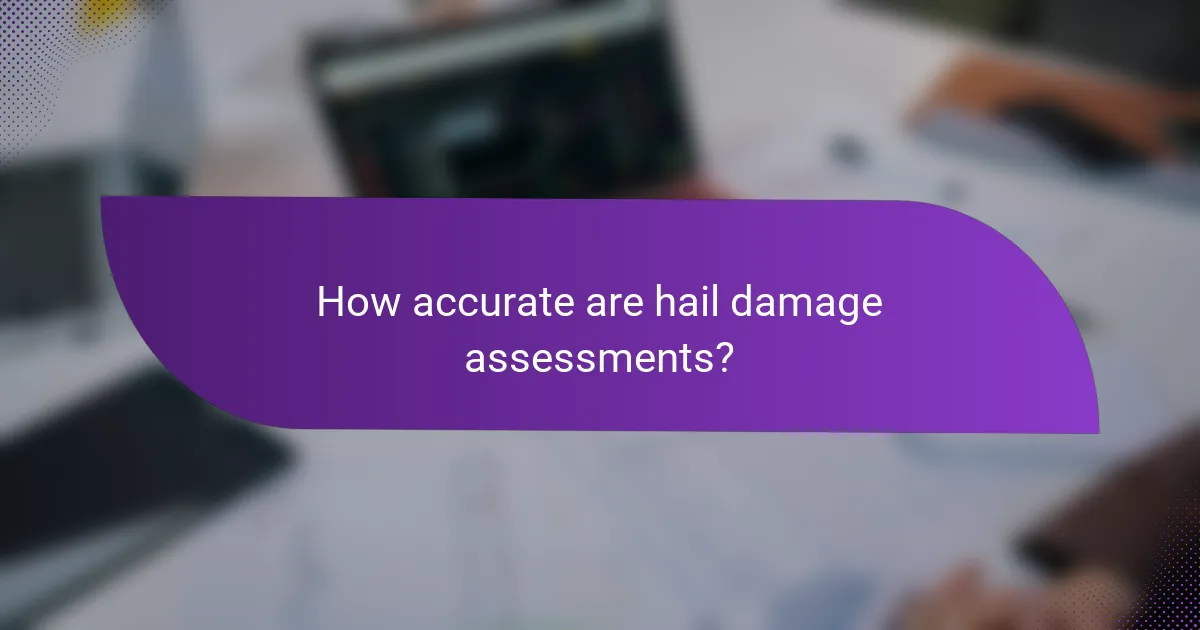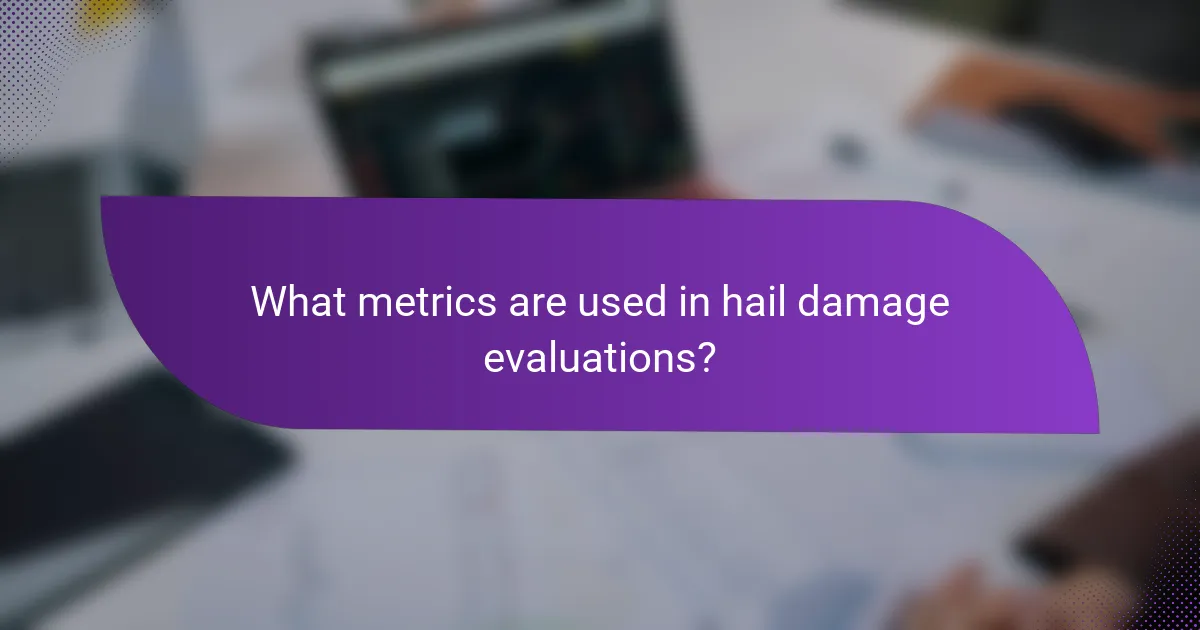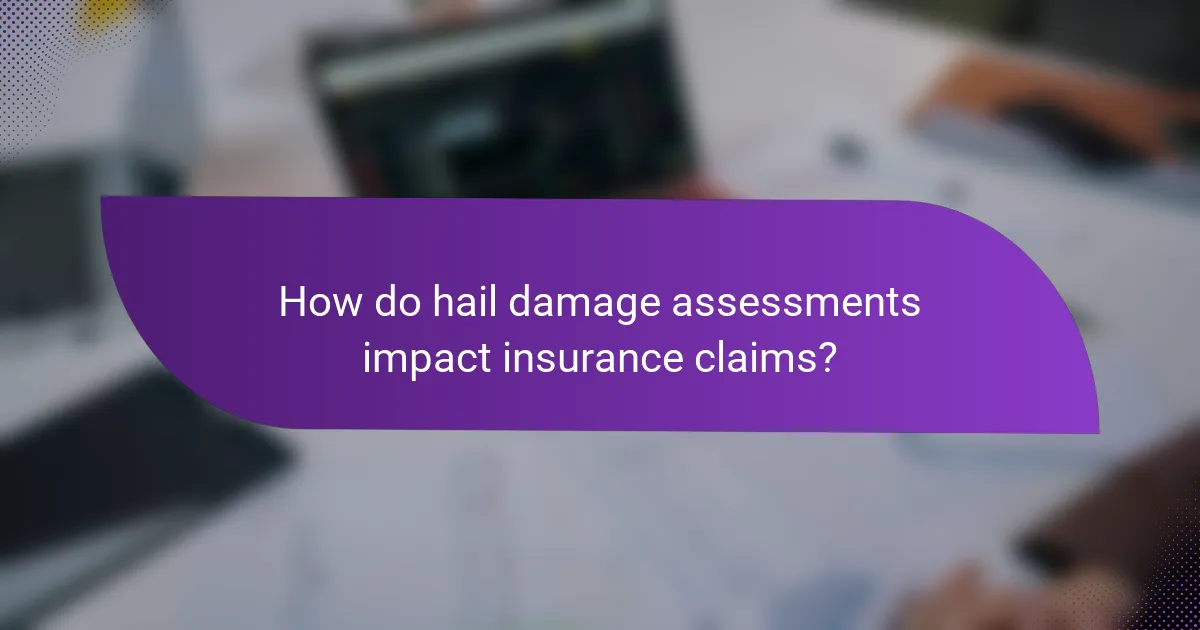Hail damage assessments are essential for accurately evaluating the impact of hailstorms on properties, utilizing specialized tools that offer real-time data and geographic insights. The accuracy of these assessments typically ranges from 70% to 90%, making the choice of methods and tools critical for effective insurance claims and repair decisions. Key metrics, including hailstone size and damage estimates, play a vital role in guiding the evaluation process and ensuring informed decision-making.

What are the best tools for hail damage assessments in Ireland?
The best tools for hail damage assessments in Ireland include specialized software that provides real-time data, weather impact analysis, and geographic insights. These tools help professionals accurately evaluate damage and make informed decisions regarding repairs and insurance claims.
HailTrace for real-time data
HailTrace offers real-time data on hail events, allowing users to track storms as they develop. This tool provides detailed maps showing hail size, path, and intensity, which are crucial for assessing potential damage in specific areas.
When using HailTrace, consider its integration with other data sources to enhance accuracy. For instance, combining HailTrace data with local weather reports can provide a comprehensive view of storm impacts.
AccuWeather for weather impact analysis
AccuWeather is renowned for its weather forecasting capabilities, which can be instrumental in hail damage assessments. It provides forecasts and historical data that help users understand how weather patterns may affect hail occurrences.
Utilizing AccuWeather can aid in planning for future storms and assessing past events. Users should regularly check for updates, as weather conditions can change rapidly, impacting the accuracy of damage assessments.
GeoIQ for geographic insights
GeoIQ specializes in geographic information systems (GIS) that enhance hail damage assessments by providing spatial analysis. This tool helps users visualize the distribution of hail damage across different regions, making it easier to prioritize areas for inspection and repair.
Incorporating GeoIQ into your assessment process can improve decision-making. Be sure to consider local geographic features, as they can influence hail impact and damage severity in various locations throughout Ireland.

How accurate are hail damage assessments?
Hail damage assessments can vary in accuracy based on the methods and tools used, typically achieving reliability rates between 70% to 90%. The precision of these evaluations is crucial for effective insurance claims and repair decisions.
Accuracy metrics of leading tools
Leading hail damage assessment tools often utilize a combination of aerial imagery, ground inspections, and machine learning algorithms to evaluate damage. Metrics such as the percentage of accurate damage identification and the time taken for assessments are commonly used to measure effectiveness. For instance, some tools report accuracy rates of around 85% when comparing assessments against physical inspections.
Additionally, tools may provide a confidence score that indicates the reliability of their assessments. This score helps users understand the potential variability in the evaluation, guiding them in decision-making processes.
Factors affecting assessment accuracy
Several factors can influence the accuracy of hail damage assessments, including the size and intensity of the hail, the type of roofing material, and the time elapsed since the storm. For example, larger hailstones typically cause more significant damage, making it easier to assess accurately. In contrast, smaller hail may lead to subtle damage that is harder to detect.
Environmental conditions, such as lighting and weather, also play a role. Assessments conducted immediately after a storm may yield different results than those performed days later due to changes in visibility and the potential for additional damage. Understanding these factors can help in selecting the right assessment method and timing for optimal accuracy.

What metrics are used in hail damage evaluations?
Hail damage evaluations primarily rely on metrics such as the size and frequency of hailstones, property damage estimates, and the implications for insurance claims. These metrics help assess the extent of damage and guide necessary repairs and claims processes.
Size and frequency of hailstones
The size of hailstones is a critical metric in evaluating damage, as larger stones typically cause more severe impacts. Hailstones can range from small pellets of a few millimeters to golf ball-sized or larger stones exceeding 5 centimeters in diameter. The frequency of hail events in a specific area also plays a role in determining potential damage, as regions prone to frequent hailstorms may experience cumulative effects over time.
When assessing hailstone size, it is useful to categorize them into classes, such as small (1-2 cm), medium (2-4 cm), and large (4+ cm). This classification helps in estimating the potential for damage to roofs, vehicles, and crops.
Property damage estimates
Property damage estimates are derived from the observed impact of hail on structures and vehicles. Evaluators often use visual inspections and damage assessment tools to estimate repair costs. Commonly, damage can range from minor cosmetic issues to significant structural impairments, with estimates varying widely based on the extent of the damage.
For example, minor roof damage may cost a few hundred USD to repair, while extensive damage requiring a full roof replacement could run into the thousands. Accurate estimates are essential for homeowners and businesses to understand their financial exposure and to facilitate insurance claims.
Insurance claim implications
The metrics used in hail damage evaluations directly influence insurance claims. Insurers typically require detailed assessments to determine coverage and payout amounts. Understanding the size and frequency of hailstones, along with property damage estimates, helps policyholders present a strong case for their claims.
Policyholders should document all damage with photographs and detailed descriptions, as this can expedite the claims process. Additionally, being aware of local regulations and insurance policy specifics can help ensure that claims are filed correctly and efficiently, maximizing potential reimbursements.

What are the steps in conducting a hail damage assessment?
Conducting a hail damage assessment involves a systematic approach to evaluate the extent of damage caused by hail. Key steps include an initial site inspection, thorough data collection and analysis, followed by reporting the findings to stakeholders.
Initial site inspection
The initial site inspection is crucial for identifying visible signs of hail damage. Inspectors should look for dents on vehicles, damage to roofs, and affected landscaping. It’s important to document the condition of the property before any repairs are made.
During this inspection, assessors should take photographs and notes to support their findings. Using a checklist can help ensure that no critical areas are overlooked, such as gutters, siding, and windows.
Data collection and analysis
Data collection involves gathering quantitative and qualitative information about the damage. This includes measuring the size of hailstones, estimating the area affected, and noting the type of materials involved. Utilizing tools like hail impact charts can aid in determining the severity of the damage.
After collecting data, analysis is performed to assess the overall impact. This may involve comparing the findings against industry standards or historical data to evaluate the extent of damage and potential repair costs.
Reporting findings
Reporting findings is the final step in the hail damage assessment process. A comprehensive report should include detailed descriptions of the damage, photographs, and analysis results. This report serves as a critical document for insurance claims and repair planning.
When preparing the report, clarity is key. Use straightforward language and organize the information logically. Highlight any urgent repairs needed and provide estimated costs to facilitate decision-making for property owners and insurers.

What criteria should be considered when selecting a hail damage assessment tool?
When selecting a hail damage assessment tool, consider its accuracy, ease of integration with existing systems, and cost-effectiveness. These factors will help ensure that the tool meets your specific needs while providing reliable results.
Integration with existing systems
Choosing a hail damage assessment tool that integrates seamlessly with your current systems is crucial. Look for tools that offer APIs or plugins for popular software platforms, which can streamline workflows and reduce data entry errors.
For example, if your organization uses a specific claims management system, ensure the assessment tool can easily connect to it. This integration can save time and improve the overall efficiency of the damage assessment process.
Cost-effectiveness and pricing plans
Cost-effectiveness is a key consideration when evaluating hail damage assessment tools. Compare pricing plans across different providers to find options that fit within your budget while still delivering the necessary features.
Many tools offer tiered pricing based on usage or features, so assess your needs carefully. A tool that charges a monthly fee may be more economical for smaller operations, while larger organizations might benefit from an annual plan that offers a discount.

How do hail damage assessments impact insurance claims?
Hail damage assessments play a crucial role in determining the validity of insurance claims. Accurate evaluations can significantly influence the amount of compensation policyholders receive, as well as the overall claims process.
Claim validation processes
Insurance companies rely on hail damage assessments to validate claims submitted by policyholders. These assessments typically involve inspections by adjusters who evaluate the extent of damage to property, vehicles, or crops. The findings help insurers decide whether to approve or deny a claim based on the policy’s coverage terms.
To ensure a thorough evaluation, it’s essential for policyholders to document the damage with photographs and to keep records of any repairs. This documentation can support the claim and expedite the validation process.
Impact on policy premiums
The outcome of hail damage assessments can directly affect policy premiums. If a claim is approved and the insurer pays out a significant amount, the policyholder may face increased premiums upon renewal. Insurers often adjust rates based on the frequency and severity of claims in a specific area.
Policyholders should be aware that frequent claims, even for minor hail damage, can lead to higher premiums. It may be beneficial to weigh the cost of repairs against potential premium increases before filing a claim. Understanding these dynamics can help in making informed decisions about insurance coverage and claims.

What are the common challenges in hail damage assessments?
Hail damage assessments face several challenges that can affect their accuracy and reliability. Key issues include data reliability, subjective interpretations, and the variability of hail events, which can complicate the evaluation process.
Data reliability issues
Data reliability is a significant challenge in hail damage assessments, as the quality and accuracy of the information collected can vary widely. Factors such as the source of the data, the methods used for collection, and the time elapsed since the hail event can all impact reliability.
For instance, assessments based on eyewitness accounts may be less reliable than those using advanced technology, such as radar or satellite imagery. It’s crucial to cross-reference data from multiple sources to enhance accuracy and reduce the risk of errors.
When conducting assessments, consider using standardized data collection methods and tools to ensure consistency. This may include using specific software for damage estimation or adhering to industry guidelines for reporting hail damage.
